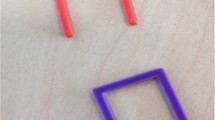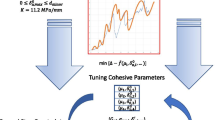Abstract
Super-elastic bone staples have emerged as a safe and effective alternative for internal fixation. Nevertheless, several biomechanical aspects of super-elastic staples are still unclear and require further exploration. Within this context, this study presents a combined experimental and computational approach to investigate the mechanical characteristics of super-elastic staples. Two commercially available staples with distinct geometry, characterized by two and four legs, respectively, were examined. Experimental four-point bending tests were conducted to evaluate staple performance in terms of generated forces. Subsequently, a finite element-based calibration procedure was developed to capture the unique super-elastic behavior of the staple materials. Finally, a virtual bench testing framework was implemented to separate the effect of geometry from that of the material characteristics on the mechanical properties of the devices, including generated force, strain distribution, and fatigue behavior. The experimental tests indicated differences in the force vs. displacement curves between staples. The material calibration procedure revealed marked differences in the super-elastic properties of the materials employed in staple 1 and staple 2. The results obtained from the virtual bench testing framework have showed that both geometric features and material characteristics had a substantial impact on the mechanical properties of the device, especially on the generated force, whereas their effect on strain distribution and fatigue behavior was comparatively less pronounced. To conclude, this study advances the biomechanical understanding of Nitinol super-elastic staples by separately investigating the impact of geometry and material characteristics on the mechanical properties of two commercially available devices.








Similar content being viewed by others
References
Aiyer, A., N. A. Russell, M. H. Pelletier, and W. R. Walsh. The impact of Nitinol staples on the compressive forces, contact area, and mechanical properties in comparison to a claw plate and crossed screws for the first tarsometatarsal arthrodesis. Foot Ankle Spec. 9:232–240, 2016.
ASTM. F2005 05—Standard Terminology for Nickel–Titanium Shape Memory Alloys. West Conshohocken: ASTM, 2015.
ASTM. F564 17—Standard Specification and Test Methods for Metallic Bone Staples. West Conshohocken: ASTM, 2017.
Auricchio, F., and R. L. Taylor. Shape-memory alloys: modelling and numerical simulations of the finite-strain superelastic behavior. Comput. Methods Appl. Mech. Eng. 143:175–194, 1997.
Berti, F., S. Bridio, G. Luraghi, S. Pant, D. Allegretti, G. Pennati, and L. Petrini. Reliable numerical models of nickel–titanium stents: how to deduce the specific material properties from testing real devices. Ann. Biomed. Eng. 50:467–481, 2022.
Bologna, F. A., A. L. Audenino, and M. Terzini. Bone plates runout prediction through tensile strength and geometric properties for regulatory mechanical testing. Ann. Biomed. Eng. 2023.
Caputo, R. J., and J. B. Bennett. Power staple fixation in trapeziometacarpal arthrodesis. J. Hand Surg. Am. 18:926–929, 1993.
Carbonaro, D., C. Chiastra, U. Morbiducci, and A. Audenino. Transcatheter aortic valve with embolic filter: experiments and simulations. In: Convegno Nazionale di Bioingegneria, 2020.
Carbonaro, D., D. Gallo, U. Morbiducci, A. Audenino, and C. Chiastra. In silico biomechanical design of the metal frame of transcatheter aortic valves: multi-objective shape and cross-sectional size optimization. Struct. Multidiscip. Optim. 64:1825–1842, 2021.
Carbonaro, D., A. Lucchetti, A. L. Audenino, T. Gries, T. J. Vaughan, and C. Chiastra. Multi-objective design optimization of bioresorbable braided stents. Comput. Methods Programs Biomed.242:107781, 2023.
Carbonaro, D., S. Zambon, A. Corti, D. Gallo, U. Morbiducci, L. Audenino, and C. Chiastra. Impact of nickel–titanium super-elastic material properties on the mechanical performance of self-expandable transcatheter aortic valves. J. Mech. Behav. Biomed. Mater.138:105623, 2023.
Carpinteri, A., C. Ronchei, A. Spagnoli, and S. Vantadori. On the use of the Prismatic Hull method in a critical plane-based multiaxial fatigue criterion. Int. J. Fatigue. 68:159–167, 2014.
Corti, A., M. Colombo, J. M. Rozowsky, S. Casarin, Y. He, D. Carbonaro, F. Migliavacca, J. F. R. Matas, S. A. Berceli, and C. Chiastra. A predictive multiscale model of in-stent restenosis in femoral arteries: linking haemodynamics and gene expression with an agent-based model of cellular dynamics. J. R. Soc. Interface. 19:20210871, 2022.
Curenton, T. L., B. L. Davis, J. E. Darnley, S. D. Weiner, and J. S. Owusu-Danquah. Assessing the biomechanical properties of Nitinol staples in normal, osteopenic and osteoporotic bone models: a finite element analysis. Injury. 52:2820–2826, 2021.
Dock, C. C., K. L. Freeman, J. C. Coetzee, R. S. Mcgaver, and M. R. Giveans. Outcomes of Nitinol compression staples in tarsometatarsal fusion. Foot Ankle Orthop. 5:2473011420944904, 2020.
Duerig, T., D. Stoeckel, and D. Johnson. Smart materials for medical applications. In: European Workshop on Smart Structures in Engineering and Technology. 2003.
Gilles, G. A., and R. M. Simin. Power-staple fixation in foot and ankle surgery. J. Foot Surg. 29:154–161, 1990.
Hickernell, F. J., H. S. Hong, P. L’écuyer, and C. Lemieux. Extensible lattice sequences for quasi-Monte Carlo quadrature. SIAM J. Sci. Comput. 22:1117–1138, 2001.
Holland, J. H. Genetic algorithms. Sci. Am. 267:66–73, 1992.
Hoon, Q. J., M. H. Pelletier, C. Christou, K. A. Johnson, and W. R. Walsh. Biomechanical evaluation of shape-memory alloy staples for internal fixation—an in vitro study. J. Exp. Orthop. 3(1):19, 2016.
Jacob Malal, J. G., G. Hegde, and R. D. Ferdinand. Tarsal joint fusion using memory compression staples—a study of 10 cases. J. Foot Ankle Surg. 45:113–117, 2006.
Jones, D. R., M. Schonlau, and W. J. Welch. Efficient global optimization of expensive black-box functions. J. Glob. Optim. 13:455–492, 1998.
Lekston, Z., D. Stroz, and M. Jędrusik-Pawłowska. Preparation and characterization of Nitinol bone staples for cranio-maxillofacial surgery. J. Mater. Eng. Perform. 21:2650–2656, 2012.
Michael, S. ABAQUS/Standard User’s Manual, Version 6.9. Johnston: Dassault Systèmes Simulia Corp, 2009.
Mow, E. M., and H. D. Darby. Powered metaphyseal stapler: an effective and simplified internal fixation system used in multiple types of podiatric surgery. J. Foot Surg. 30:558–563, 1991.
Mwangi, J. W., L. T. Nguyen, V. D. Bui, T. Berger, H. Zeidler, and A. Schubert. Nitinol manufacturing and micromachining: a review of processes and their suitability in processing medical-grade Nitinol. J. Manuf. Process. 38:355–369, 2019.
Rethnam, U., J. Kuiper, and N. Makwana. Mechanical characteristics of three staples commonly used in foot surgery. J. Foot Ankle Res. 2:5, 2009.
Russell, S. M. Design considerations for Nitinol bone staples. J. Mater. Eng. Perform. 18:831–835, 2009.
Safranski, D., K. Dupont, and K. Gall. Pseudoelastic Nitinol in orthopaedic applications. Shape Mem. Superelast. 6:332–341, 2020.
Safranski, D. L., S. C. Chapman, Z. Wee, C. R. Lareau, Z. T. Ritter, J. D. Seybold, and J. Y. Kwon. Effect of bone quality and leg depth on the biomechanical performance of a Nitinol staple. J. Foot Ankle Surg. 61:93–98, 2022.
Schipper, O. N., S. E. Ford, P. W. Moody, B. Van Doren, and J. K. Ellington. Radiographic results of Nitinol compression staples for hindfoot and midfoot arthrodeses. Foot Ankle Int. 39:172–179, 2018.
Shibuya, N., S. N. Manning, A. Meszaros, A. M. Budny, D. S. Malay, and G. V. Yu. A compression force comparison study among three staple fixation systems. J. Foot Ankle Surg. 46:7–15, 2007.
Subasi, O., S. Torabnia, and I. Lazoglu. In silico analysis of Superelastic Nitinol staples for trans-sternal closure. J. Mech. Behav. Biomed. Mater.107:103770, 2020.
Yeung, K. W. K., K. M. C. Cheung, W. W. Lu, and C. Y. Chung. Optimization of thermal treatment parameters to alter austenitic phase transition temperature of NiTi alloy for medical implant. Mater. Sci. Eng. A. 383:213–218, 2004.
Acknowledgments
This work has been supported by the Piedmont Region, Italy (POR FESR PiTeF 2014-20 351-96, Nitiliera).
Author information
Authors and Affiliations
Contributions
DC: Conceptualization, Methodology, Software, Investigation, Data curation, Writing—original draft, Writing—review and editing. CC: Conceptualization, Writing—original draft, Writing—review and editing, Supervision. FAB: Investigation, Writing—review and editing. ALA: Writing—review and editing, Funding. MT: Conceptualization, Investigation, Writing—original draft, Writing—review and editing, Supervision.
Corresponding author
Ethics declarations
Conflict of interest
The authors declare that they have no conflict of interest.
Additional information
Associate Editor Sean S. Kohles oversaw the review of this article.
Publisher's Note
Springer Nature remains neutral with regard to jurisdictional claims in published maps and institutional affiliations.
Supplementary Information
Below is the link to the electronic supplementary material.
Rights and permissions
Springer Nature or its licensor (e.g. a society or other partner) holds exclusive rights to this article under a publishing agreement with the author(s) or other rightsholder(s); author self-archiving of the accepted manuscript version of this article is solely governed by the terms of such publishing agreement and applicable law.
About this article
Cite this article
Carbonaro, D., Chiastra, C., Bologna, F.A. et al. Determining the Mechanical Properties of Super-Elastic Nitinol Bone Staples Through an Integrated Experimental and Computational Calibration Approach. Ann Biomed Eng 52, 682–694 (2024). https://doi.org/10.1007/s10439-023-03416-6
Received:
Accepted:
Published:
Issue Date:
DOI: https://doi.org/10.1007/s10439-023-03416-6




